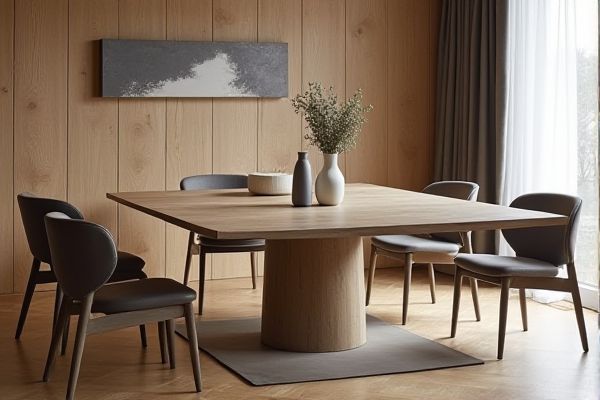
An extendable table offers flexibility by allowing you to adjust its size to accommodate more guests or save space, while a fixed table provides a stable, permanent surface with a consistent footprint ideal for smaller or designated areas. Discover which table type best suits your needs and lifestyle by reading the rest of the article.
Table of Comparison
| Feature | Extendable Table | Fixed Table |
|---|---|---|
| Definition | Table with adjustable length or rows that can be added dynamically. | Table with a set number of rows and columns, size is static. |
| Flexibility | High - easily expanded or contracted as needed. | Low - fixed size, no addition of rows or columns. |
| Use Case | Dynamic data handling, frequent updates, or unknown row count. | Static data, predefined structure, consistent row count. |
| Performance | May incur more overhead due to resizing operations. | Generally faster access due to fixed memory allocation. |
| Memory Utilization | Variable - grows or shrinks based on data. | Fixed - allocated once, no resizing needed. |
| User Experience | Interactive and adaptable to user input. | Consistent and predictable interface. |
| Complexity | Higher implementation complexity. | Lower complexity, simpler design. |
Introduction to Extendable and Fixed Tables
Extendable tables offer versatile functionality, allowing you to adjust their size to accommodate varying numbers of guests, while fixed tables provide a stable, permanent surface with a consistent footprint. The choice between an extendable table and a fixed table depends on your space constraints and typical usage needs. Extendable tables maximize flexibility for gatherings, whereas fixed tables often excel in durability and design simplicity.
Key Differences Between Extendable and Fixed Tables
Extendable tables offer versatile seating capacity by incorporating additional leaves, making them ideal for accommodating varying guest numbers and optimizing space. Fixed tables provide a consistent size and stability, typically featuring superior durability due to a solid, non-adjustable structure. The choice between extendable and fixed tables depends on the need for flexibility versus permanence in dining or workspace arrangements.
Space-Saving Benefits of Extendable Tables
Extendable tables offer significant space-saving benefits by allowing you to adjust their size based on your needs, making them ideal for small apartments or multipurpose rooms. Unlike fixed tables, extendable tables can expand to accommodate guests and then retract to conserve space when not in use. This flexibility ensures efficient use of your living area without sacrificing functionality or style.
Durability and Stability: Fixed Tables Compared
Fixed tables generally offer superior durability and stability due to their solid construction and fewer moving parts, which reduces wear and tear over time. These tables are often made from robust materials like hardwood or metal, providing a stable surface that withstands heavy use without wobbling or damage. If you prioritize long-term sturdiness and a firm workspace, your best option is a fixed table.
Design and Style Variations
Extendable tables offer versatile design options, adapting seamlessly between compact and spacious layouts, making them ideal for dynamic spaces and varying guest numbers. Fixed tables often showcase consistent style elements with a stable frame, providing a timeless, solid aesthetic best suited for dedicated dining areas. Your choice depends on whether you prioritize adaptability or a steady design presence in your interior.
Practical Uses for Extendable Tables
Extendable tables offer versatile solutions for spaces that require adaptable seating arrangements, making them ideal for small apartments or multi-functional rooms. They allow you to effortlessly increase surface area during gatherings or meals, accommodating more guests without permanently occupying extra space. Your ability to switch between compact and expanded forms enhances both convenience and functionality in daily living environments.
Cost Considerations: Extendable vs Fixed Tables
Extendable tables typically have a higher upfront cost due to their complex mechanisms and versatile design compared to fixed tables, which are simpler and generally more affordable. However, the long-term value of extendable tables can surpass fixed tables by accommodating varying guest numbers and saving space efficiently. Fixed tables may incur extra costs if replacement or larger sizes are needed over time, reducing their cost-effectiveness for growing households.
Maintenance and Longevity
Extendable tables typically require more maintenance due to moving parts such as hinges and extension mechanisms, which may wear out or need lubrication over time. Fixed tables have fewer components that can break or malfunction, resulting in generally greater longevity and less frequent repairs. Choosing materials like solid wood or high-quality metal can enhance durability regardless of table type.
Best Scenarios for Each Table Type
Extendable tables are ideal for households that frequently host guests or require flexible seating arrangements due to their ability to adjust size as needed. Fixed tables suit smaller spaces or minimalist designs where consistent dimensions and stable structure support daily use without the need for adjustment. Selecting between extendable and fixed tables depends on balancing space availability, usage frequency, and versatility requirements.
Which Table Should You Choose?
Choosing between an extendable table and a fixed table depends on your space and lifestyle needs. Extendable tables offer versatile seating options, perfect for accommodating guests, while fixed tables provide a stable, compact design ideal for smaller areas. Your selection should balance flexibility with room size to optimize functionality and comfort.
 homyna.com
homyna.com